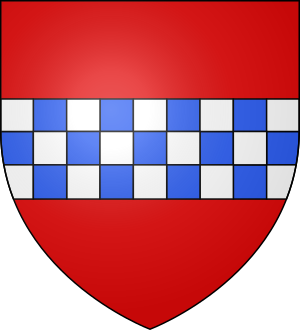James Lindsay of Crawford (died 1395/6) facts for kids
Quick facts for kids
James Lindsay
|
|
|---|---|
| Knight Banneret Lord of Crawford |
|

Arms: Gules, a fess chequy argent and azure
|
|
| Predecessor | James Lindsay of Crawford |
| Successor | David Lindsay, 1st Earl of Crawford |
| Died | 1395/6 |
| Spouse(s) | Margaret Keith (m.) |
Sir James Lindsay (died 1395/6) was an important Scottish noble. He held many titles, including the 9th Lord of Crawford. He was also a Knight Banneret, which meant he was a knight who could lead his own group of soldiers under his own flag. Sir James owned many lands, like Crawford, Kirkmichael, and Wigton. He was a powerful feudal lord in Scotland, meaning he held land from the king in exchange for loyalty and military service.
Contents
Sir James Lindsay's Life
Sir James was often seen with the King, Robert II, and was known as the King's nephew (nepos Regis). He took part in important meetings of the Scottish Parliament in 1371. He even helped sign a document that decided who would be the next king after Robert II.
From 1374 to 1395, King Richard II of England often gave Sir James special permission to travel safely through England. This permission was called a "safe-conduct." In 1394, he was chosen to be an ambassador, which meant he represented Scotland in talks with England. Sir James and his cousin, Sir David of Glenesk, made special agreements about who would inherit their lands.
Sir James was also a judge in the northern part of Scotland in 1373. He was also the Sheriff of Lanark, which meant he was in charge of law and order in that area. He was involved in the famous Battle of Otterburn and was even captured by an English bishop. He also helped arrange a famous fight between two Scottish clans, Clan Chattan and Clan Kay, to end their disagreements.
Early Life and Challenges
Sir James likely became the Lord of Crawford around 1357, after his father passed away. He was present when Robert II was crowned King in Stirling in 1371. The King made him the Sheriff of Lanark and a top judge for northern Scotland.
In 1371 and 1381, he was part of a group that talked with England to solve problems between the two countries. In 1381, Sir James had a serious disagreement with Sir John Lyon of Glamis. This event started a long-lasting feud, or bitter quarrel, between the Lindsay and Lyon families. Sir James had to leave Scotland for a while. During this time, he went on a pilgrimage, a religious journey, to a holy place in Canterbury, England. Eventually, with help from other powerful nobles, he was allowed to return to Scotland in 1383 and was pardoned for his actions. That same year, he joined a military trip into England.
The Battle of Otterburn
Sir James Lindsay fought bravely alongside the Earl of Douglas at the Battle of Otterburn on August 19, 1388. A famous historian named Froissart wrote about how Sir James was one of the first to find the Earl of Douglas after he was badly wounded and dying.
Some people believe Sir James is the "lorde of Bowghan in armure bryght" mentioned in an old song about the battle. He is also called "Lord of Crawford and Buchan" in another historical book. Froissart also wrote a lot about what happened to Sir James after the battle.
Sir James had a one-on-one fight with Sir Matthew Redman, who was in charge of the English town of Berwick. Sir Matthew's sword was knocked away, and he surrendered to Sir James. He promised to return to Edinburgh by a certain date and was allowed to go to Newcastle. However, that same night, Sir James and his squire (a knight's assistant) got lost. The next morning, they accidentally rode into a group of English soldiers, thinking they were friends. They were then taken prisoner.
Later, it was agreed that Sir James would be set free in exchange for Sir Matthew Redman. Even though the King sent a message to delay his release, Sir James was eventually freed.
Later Life and Legacy
While Sir James was away, Robert de Keith had a fight with Sir James's wife, who was his aunt. Robert de Keith had surrounded her in her Fyvie Castle in Aberdeenshire, trying to take it. So, in 1395, Sir James attacked Robert de Keith and defeated him.
Not long after, Sir James was sent with another noble, the Earl of Moray, to help settle a big disagreement between two Scottish clans, Clan Chattan and Clan Kay. They decided that the best way to end the fight was for thirty chosen men from each clan to battle it out in front of the King. This famous event happened on the North Inch of Perth and is described in Sir Walter Scott's book, Fair Maid of Perth.
Sir James Lindsay died sometime before April 22, 1396. In 1392, he started a religious house for a group called the Trinitarians in Dundee. This place later became a hospital for older citizens who needed help.
Family and Inheritance
Sir James married Margaret, the daughter of Sir William Keith, who was a very important official in Scotland. Margaret is mentioned in historical writings for defending Fyvie Castle when her nephew attacked it in 1395. She lived longer than her husband.
Sir James had two daughters:
- Margaret, who married Sir Thomas Colville.
- Eufemia, who married Sir John Herries of Terregles.
These daughters inherited their father's lands that he had not set aside for a male heir. Because Sir James did not have any sons, the important title of Lord of Crawford passed to his cousin, Sir David Lindsay of Glenesk, who later became the 1st Earl of Crawford.
See also

